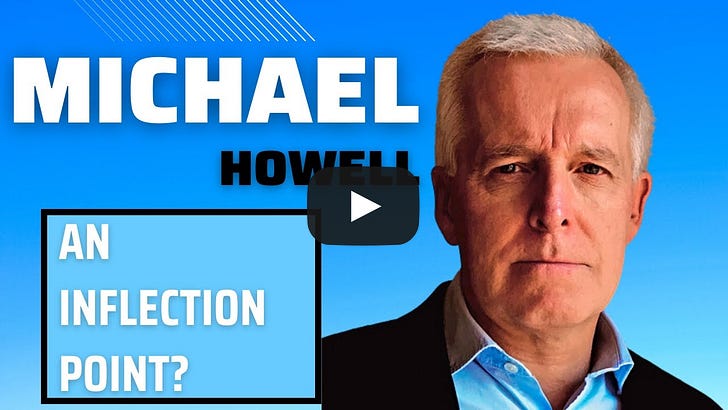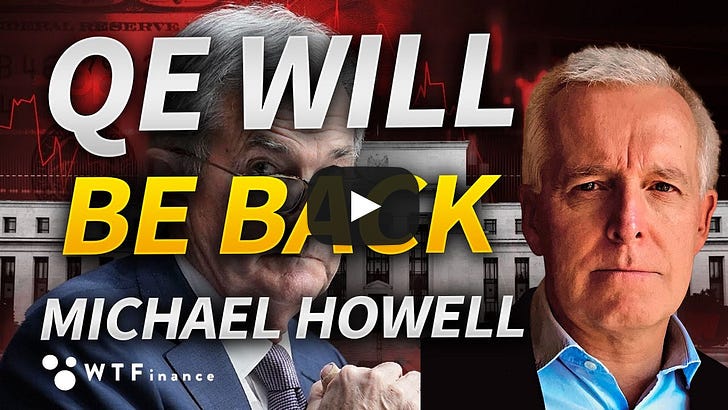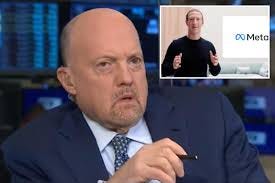You are a free subscriber to Me and the Money Printer. To upgrade to paid and receive the daily Capital Wave Report - which features our Red-Green market signals, subscribe here. The Interviews That Shaped the Post-GFC Market - No. 2 - Michael Howell's 2023 ReflectionsI'm glad I read Howell's liquidity projections in December 2022... because it reshaped and helped explain a worldview that remains undefeated since COVID... and I had a hell of a 2023.Dear Fellow Traveler, On December 15, 2022, I sat down to write my 2023 outlook (as one does…). I wrote that I expected the S&P 500, then sitting near 3,840, would finish the year down around 3,250. The reasons - continued tightening by the Fed and higher rates and valuations… Then… on January 5, 2023… I changed my tune… and raised my annual outlook to 4,200… Then, I recommended SkyWest Airlines (SKYW)… Yeah, something happened. It wasn’t just that China had started to inject its capital into the markets on the backside of COVID. It wasn’t that the Fed had shifted its tune on Mortgage Securities or that Janet Yellen was now suddenly turning her attention to the front end of the yield curve with more short-term T-Bill issuance. It was a column by Michael Howell in The Financial Times. Howell - who is ranked 7th on Substack in Finance (and a highly recommended read) - had radically altered my view on the financial system in this Opinion Article on GLOBAL LIQUIDITY - two years after I read his book Capital Wars... At the time, he noted that the Global Liquidity - with an emphasis on the post-GILT crisis market - had bottomed out… and that most investors had missed this. Howell defines Global Liquidity as “All available cash and credit in the financial system, influencing asset prices and global economic activity.” He wrote that a stealth form of Quantitative Easing was coming to the markets… We remember that in October 2022, Jim Cramer was on air crying about his “wrong call” on Meta Platforms. But interestingly enough, it wasn’t really about Meta. Cramer’s timing was off… The downturn in 2022 was linked to liquidity tightening in the global system… Suddenly, my reading of Howell’s book in 2021 really made sense. Oh… I realized… when reading his FT article… they’re ALL printing money… but they’re just not saying that they’re printing money… Then, another moment came that helped me build conviction for the year… On February 7, 2023, Howell sat down with Julia La Roche to explain his definition of global liquidity. It is a master class in explaining how markets truly function… The reality that $300 trillion in debt must be refinanced… that most new money plugged into the system refinances that debt… and that the rest of the capital doesn’t just originate from the Federal Reserve. It can - and will - originate from the shadow banking system that dwarfs our understanding of modern, regulated banks.  At minute 30, there is a critical part of the interview that should shake everyone who tries to wrap their head around what the Federal Reserve does… As I’ve said, only 6% of Americans understand that the job of the Federal Reserve is to stabilize employment and control prices (inflation). But less than 1% know the truth. And Howell lays it out succinctly. The job of central banks is to ensure financial stability constantly… And that’s it… whatever it takes. What Came NextThe Silicon Valley Bank implosion that followed just a month after this interview confirmed what Howell argues here. The Fed couldn’t just start turning on the money printer. They couldn’t do Quantitative Easing. So, they started to create programs that weren’t QE. They were aiming to achieve QE-like outcomes. Call it whatever you want: Quantitative Support (a Howell term), the Bank Term Funding Program (which provided liquidity to banks), or expansions in repo operations. It’s all about stability. And the broker-dealers always come before the citizenry. Meanwhile, the Treasury Department’s continued focus on the short-end of bill issuance helped turbo-charge liquidity as well. As Howell has noted, the Treasury started engaging in actions to control the yield curve… without calling it “Yield Curve Control” - or fiscal repression. It’s a reminder to never listen to what they say - and only what they do. What Happened In 2023?After the markets recovered in 2023 - and people were still scratching their heads - Howell would later point out that global liquidity had expanded by over $9 trillion without the Fed doing much of anything. It was the Shadow Banking system that did it.. Remember when your parents told you Santa wasn't real? Michael Howell would soon do that to the entire financial system. On October 20, 2023, Howell sat down with WTFinance and casually explained how central banks had been running a massive money-printing operation while swearing on their mothers' graves they weren't printing money. Why? At the time, the 10-year U.S. Treasury bond had cracked toward 5%… and there were deep concerns that we might be heading toward 6%… which would effectively have made Bank of America insolvent.  Howell called it "Shadow QE." Or - Not QE, QE. It was the biggest gaslighting operation since someone convinced us NFTs were art. While Jerome Powell was standing at podiums talking about "quantitative tightening" and "fighting inflation," the Fed and its global buddies were pumping liquidity into markets through the back door. It's like your spouse saying they're on a diet while secretly eating cake in the garage at 2 AM. The tools?
They stopped calling it QE. They didn't stop doing QE. Imagine changing your name after robbing a bank… And getting away with it by saying… "That wasn't me, that was Steve." Follow the Liquidity, Not the LipsHowell’s global liquidity measure bottomed in late 2022. Then… something happened… The Fed was raising rates with one hand, and injecting liquidity with the other. The 2023 market rally that "nobody could explain"? Howell explained it: Shadow QE. This is liquidity injections through Treasury and central bank balance sheet operations that mimic QE without being labeled as official quantitative easing. And it's not just the Fed.
It's a global liquidity orgy, and your portfolio is invited. The password is “Fidelio.” The Asset Price Magic ShowHere’s what we can deduce on the investment side of things from these interviews… Bonds? Not good for long-term premiums. Why? Because shadow liquidity is propping up a system that should have already cracked. Hedge funds are leveraged to the tilt on “safe assets” like Treasuries… Hoo boy… And if this all unwinds… yields are going higher, and bonds will get smoked… Stocks? Probably going higher, not because companies are doing great. Because there's so much hidden money sloshing around, it has to go somewhere. It's like musical chairs, except they keep adding chairs when the music stops. And it also explains the “fundamentals” problem that the markets have today… Why do P/E ratios make no sense anymore? Shadow QE. Why are zombie companies still alive? Shadow QE. Why is your cousin's dog walking app worth $50 million? You guessed it. This is why Howell’s argued that P/E ratios aren’t what they used to be… Instead, look at domestic liquidity… That’s the real measure… But also… ETFs… leverage… and short-term repo operations. This is well above most people’s pay grades, and people with CFAs and MBAs will read this and say, “This is all insane… That’s not how the market works…” But it is… and it’s been this way for decades. What the hell do you think Long Term Capital Management’s implosion was about? Interest rates? No… it was a shadow banking issue. LTCM was levered up at over 25:1 at its peak and interconnected with Wall Street dealers through derivatives, repo, and swaps. LTCM created bank-like credit and liquidity risk without deposit insurance or central bank oversight. Their losses ripped through counterparties (big investment banks), and threatened the global financial system. That’s why the Fed organized a private bailout in 1998… LTCM was the first real taste we got of shadow banking creating contagion risk. Citigroup’s SIVs in the 2000s… It was the same with Bear Stearns and Lehman Brothers in 2008… The Reserve Primary Fund in 2008… Deutsche Bank and BNP Paribas off-balance sheet vehicles in 2011… Archegos Capital Management in 2021… LDI Pension Funds in 2022 in England… FTX / Alameda Research in 2023… It’s all there… and it’s all obvious… and it’s like they’ve been trying to keep all this a secret… Narrator: They were… This is all boring, complicated, and technical. Can't Stop, Won’t StopHere’s the real problem… The system is so addicted to this hidden liquidity that removing it would cause a crash that makes 2008 look like a spa day. The Fed knows this. The ECB knows this. The BOJ has known this for 30 years. They're not running Shadow QE because they want to. They're running it because they HAVE to. It's like being on a treadmill that speeds up every time you slow down. Eventually, you're sprinting just to stay in place. Welcome to modern monetary policy, where the exit door is painted on the wall. Where everything we think we know about monetary policy is theater. Rate hikes? Theater. Quantitative tightening? Theater. Fed independence in Jackson Hole? DEFINITELY theater. The real game is happening in the shadows… through mechanisms so boring that nobody pays attention. Hide the money printing in plain sight by making it so technically complex that even financial journalists give up trying to understand it. And most have… The thing is… I’m utterly fascinated by things like this… The more complex, the better. I’ll figure it out… You're Along for the RideWhen someone like Michael Howell, who runs Crossborder Capital and has been tracking global liquidity longer than some traders have been alive, tells you the game is rigged... You don't fight it. You play it. Because shadow QE isn't ending. It's accelerating. Howell predicts it'll eventually become "official" QE again. They'll stop pretending they're not printing money and just admit it. It's like a magician getting tired of the trick and just showing you the rabbit was in the hat all along. Or that the rabbit has been dead for years… and it’s just a puppet. Howell's advice? Ride the liquidity wave until it crashes on the shore. When will that be? When central banks finally lose control of the narrative. When shadow becomes substance. When the hidden becomes exposed. Until then? Party like it's 1999. Or 2007. Or 2021. Pick your bubble. And, as I’ve discovered, focus on the tools like the FNGD to show you when leverage is leaving the market and it’s time to short… Or when it’s time to load up by watching the insiders… Howell’s talks weren’t just interviews. It was shock therapy for the entire global monetary system. We all have to keep playing along. And to that I say… good. Trade it until it breaks. Otherwise, we’d have to admit that the entire financial system is built on shadow puppets and IOU notes. And that’s where the revolution would start… Stay positive, Garrett Baldwin About Me and the Money Printer Me and the Money Printer is a daily publication covering the financial markets through three critical equations. We track liquidity (money in the financial system), momentum (where money is moving in the system), and insider buying (where Smart Money at companies is moving their money). Combining these elements with a deep understanding of central banking and how the global system works has allowed us to navigate financial cycles and boost our probability of success as investors and traders. This insight is based on roughly 17 years of intensive academic work at four universities, extensive collaboration with market experts, and the joy of trial and error in research. You can take a free look at our worldview and thesis right here. Disclaimer Nothing in this email should be considered personalized financial advice. While we may answer your general customer questions, we are not licensed under securities laws to guide your investment situation. Do not consider any communication between you and Florida Republic employees as financial advice. The communication in this letter is for information and educational purposes unless otherwise strictly worded as a recommendation. Model portfolios are tracked to showcase a variety of academic, fundamental, and technical tools, and insight is provided to help readers gain knowledge and experience. Readers should not trade if they cannot handle a loss and should not trade more than they can afford to lose. There are large amounts of risk in the equity markets. Consider consulting with a professional before making decisions with your money. |
Home » Uncategories » The Interviews That Shaped the Post-GFC Market - No. 2 - Michael Howell's 2023 Reflections
Subscribe to:
Post Comments (Atom)




0 Response to "The Interviews That Shaped the Post-GFC Market - No. 2 - Michael Howell's 2023 Reflections"
Post a Comment